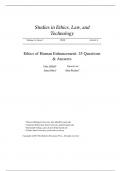Tentamen (uitwerkingen)
Ethics of Human Enhancement: 25 Questions &Answers
- Vak
- Instelling
2. Is the natural-artificial distinction morally significant in this debate? As we mentioned, strictly speaking, human enhancements seem to include such activities as reading a book, eating vegetables, doing homework, and exercising. To the extent that these “natural” enhancements are e...
[Meer zien]



